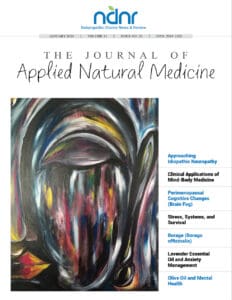Heather Paulson, ND, FABNO
Tolle Causam
Cancer-related pain is frequently experienced by cancer patients and can negatively both affect quality of life and functional status. According to the National Cancer Institute, pain occurs in 20% to 50% of patients with cancer.1 Cancer-related pain can be difficult to treat because there is a lack of unified cancer pain assessment tools, the cause of pain can be multifactorial, and the cancer treatments themselves can cause pain.2
Some strategies for managing pain effectively include the use of regular pain assessments such as the Edmonton Classification System for Cancer Pain and the Cancer Pain Prognostic Scale. One must take into consideration whether the pain is somatic, neuropathic, or visceral in nature.
Helpful questions to cover with patients with cancer pain include the following:
- Numeric pain rating scale (0 -10)
- Categorical scale (none, mild, moderate, severe)
- Location of pain
- Onset of pain
- Provocative or palliative factors
- Radiation and related symptoms
- Severity: intensity and effect on function
- Temporal pattern: continuous, intermittent
A reduction in pain is categorized as a point reduction of 2 out of 10 points or a 30% decrease on the pain scale. Appropriate treatment is the best strategy, along with regular monitoring of patients to reassess pain management strategies.
Pharmaceuticals for Pain Relief
Medications that are currently used to treat cancer-related pain vary depending on whether the pain is somatic, neuropathic, or visceral. In general, the treatments include:
- Somatic pain: acetaminophen, non-steroidal anti-inflammatory drugs (NSAIDs), opioids, radiation, lidocaine, capsaicin
- Neuropathic pain: gabapentin, tricyclic antidepressants, opioids
- Visceral pain: opioids
Some natural medicine approaches that have recently shown to be effective include acupuncture, medical cannabis, and meditation. Let’s review these emerging pain-relief methods one by one.
Acupuncture for Pain Relief
Acupuncture might be an effective addition or alternative to pain medication for cancer-related pain. Thus far, the studies on this topic are small in size and not blinded, which calls into question their validity. However, my clinical experience with cancer-related pain being resolved or controlled with acupuncture has been positive.
One study that followed 90 patients receiving acupuncture or sham points showed a significant decrease in pain intensity by 36% at 2 months in the acupuncture group (no change in the placebo group).3 Pain had also reduced in the acupuncture group at the 1-month evaluation.
Another study, involving 30 patients in the acupuncture group and 30 patients in the control group, evaluated the effect of electroacupuncture on pancreatic cancer patients.3 The study revealed that after 3 days of treatment, patients in the acupuncture group had a statistically significant reduction in pain.3
Cannabinoids for Pain Relief
The use of cannabinoids for pain relief may hold promise for cancer-related pain. This is a hot topic in cancer research and one that is frequently asked about by patients in our office. Recently, 2 placebo-controlled trials showed that adding cannabis to opioids and other pain medications provided a small benefit.4,5
A review of 29 studies looking at cannabinoids for neuropathic pain relief concluded that they were safe, effective, and reasonable for treating neuropathic pain.6,7 Studies will continue to be published on the possible benefit of cannabinoids for cancer-related pain. Speaking from a clinical observation perspective, my patients using cannabinoids for cancer-related pain relief have experienced spotty efficacy. I am looking forward to more research being published on the types of situations in which cannabinoids are best applied.
Meditation for Pain Relief
Mindfulness meditation has been shown to reduce the subjective experience of pain, according to a pain scale-rating system. Mindfulness meditation combines focused attention on the breath, with objective consideration of thoughts and sensations that occur during the focused breathing. Numerous studies have demonstrated the efficacy of mindfulness meditation as an alternative to pharmacologic intervention.
Mindfulness meditation works by changing brain function during the exercise. Imaging of the brain during mindfulness meditation has demonstrated a reduction in pain that is associated with activation of the perigenual anterior cingulate cortex (ACC), orbitofrontal cortex (OFC), and anterior insula. Because of the high level of opioid receptors in these regions of the brain, this suggests an opioidergic mechanism.8
However, studies have also shown that mindfulness meditation deactivates the periaqueductal gray (PAG) – a control center for main modulation, which is inconsistent with activation of opioid-dependent cognitive pain-modulatory mechanisms.9 In terms of other potential mechanisms of action for cancer pain relief, recent research has shown that mindfulness meditation significantly downregulates thalamic activity.10 A reduction in thalamic activity could gate sensory information that is transmitted to the cortex.
Data from studies on mindfulness mediation have also revealed increased activity in the lateral OFC/ventral-lateral PFC, and rostral ACC regions of the brain.11 This indicates an alteration of contextual pain perception. Additionally, other parts of the brain show changes that would lead to suppression of sensory events at the level of conscious awareness. These areas of the brain include the thalamic reticular nuclei (TRN) synapse, with projections from the OFC, leading to inhibition of sensory processing in the thalamus.11
Taken together, these data suggest that mindfulness meditation activates the TRN, leading to thalamic inhibition, which reduces cortical distribution of nociceptive information. It may also increase activation of ACC, OFC, and anterior insula.
References:
- National Cancer Institute. Cancer Pain (PDQ®) – Health Professional Version. Updated April 19, 2017. NCI Web site. https://www.cancer.gov/about-cancer/treatment/side-effects/pain/pain-hp-pdq. Accessed April 15, 2017.
- Stewart J. The challenges of cancer pain assessment. Ulster Med J. 2014;83(1):44-46.
- Paley CA, Johnson MI, Tashani OA, Bagnall AM. Acupuncture for cancer pain in adults. Cochrane Database Syst Rev. 2015;(10):CD007753.
- Johnson JR, Burnell-Nugent M, Lossignol D, et al. Multicenter, double-blind, randomized, placebo-controlled, parallel-group study of the efficacy, safety, and tolerability of thc:cbd extract and thc extract in patients with intractable cancer-related pain. J Pain Symptom Manage. 2010;39(2):167-179.
- Portenoy RK, Ganae-Motan ED, Allende S, et al. Nabiximols for opioid-treated cancer patients with poorly-controlled chronic pain: a randomized, placebo-controlled, graded-dose trial. J Pain. 2012;13(5):438-449.
- Lynch ME, Campbell F. Cannabinoids for treatment of chronic, non-cancer pain; a systematic review of randomized trials. Brit J Clin Pharmacol. 2011;72(5):735-744.
- Lynch M, Ware MA. Cannabinoids for the treatment of chronic non-cancer pain: an updated systematic review of randomized controlled trials. J Neuroimmune Pharmacol. 2015;10(2):293-301.
- Nakata H, Sakamoto K, Kakigi R. Meditation reduces pain-related neural activity in the anterior cingulate cortex, insula, secondary somatosensory cortex, and thalamus. Front Psychol. 2014;5;1489.
- Zeidan F, Adler-Neal AL, Wells RE, et al. Mindfulness-Meditation-Based Pain Relief Is Not Mediated by Endogenous Opioids. J Neurosci. 2016;36(11):3391-3397.
- Zeidan F, Martucci KT, Kraft RA, et al. Brain mechanisms supporting the modulation of pain by mindfulness meditation. J Neurosci. 2011;31(14):5540-5548.
- Zeidan F, Emerson NM, Farris SR, et al. Mindfulness Meditation-Based Pain Relief Employs Different Neural Mechanisms Than Placebo and Sham Mindfulness Meditation-Induced Analgesia. J Neurosci. 2015;35(46):15307-15325.
Image Copyright: <a href=’https://www.123rf.com/profile_rgbspace’>rgbspace / 123RF Stock Photo</a>
 Heather Paulson, ND, FABNO, focuses on helping people diagnosed with cancer and hematological disorders reconnect with their natural state of wellness. Dr Paulson is a Fellow of the American Board of Naturopathic Oncology, denoting this specialized training and focus in her practice. She teaches oncology and hematology at Southwest College of Naturopathic Medicine and also maintains a private practice at The Paulson Center in Tempe, AZ. You can contact her through her website at www.drheatherpaulson.com.
Heather Paulson, ND, FABNO, focuses on helping people diagnosed with cancer and hematological disorders reconnect with their natural state of wellness. Dr Paulson is a Fellow of the American Board of Naturopathic Oncology, denoting this specialized training and focus in her practice. She teaches oncology and hematology at Southwest College of Naturopathic Medicine and also maintains a private practice at The Paulson Center in Tempe, AZ. You can contact her through her website at www.drheatherpaulson.com.


